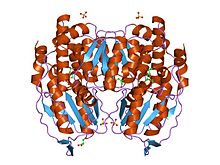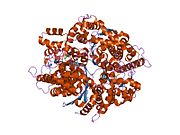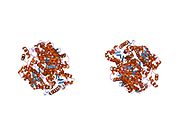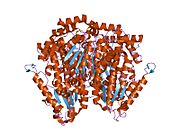User:SUJesse/Glucose-6-phosphate isomerase
| Glucose-6-phosphate isomerase | |||||||||
|---|---|---|---|---|---|---|---|---|---|
ExPASy NiceZyme view | | ||||||||
| KEGG | KEGG entry | ||||||||
| MetaCyc | metabolic pathway | ||||||||
| PRIAM | profile | ||||||||
| PDB structures | RCSB PDB PDBe PDBsum | ||||||||
| Gene Ontology | AmiGO / QuickGO | ||||||||
| |||||||||
| Bacterial phospho-glucose isomerase C-terminal region | |||||||||
|---|---|---|---|---|---|---|---|---|---|
 crystal structure of phosphoglucose/phosphomannose isomerase from pyrobaculum aerophilum in complex with fructose 6-phosphate | |||||||||
| Identifiers | |||||||||
| Symbol | bact-PGI_C | ||||||||
| Pfam | PF10432 | ||||||||
| InterPro | IPR019490 | ||||||||
| |||||||||
| Phosphoglucose isomeras | |||||||||
|---|---|---|---|---|---|---|---|---|---|
| Identifiers | |||||||||
| Symbol | PGI | ||||||||
SCOP2 | 1pgi / SCOPe / SUPFAM | ||||||||
| |||||||||
Glucose-6-phosphate isomerase (alternatively known as phosphoglucose isomerase or phosphohexose isomerase) is an
The human variant of this enzyme is encoded by the GPI gene.[1]
Structure
PGI monomers are made of two domains, one made of two separate segments called the large domain and the other made of the segment in between called the small domain [2]. The two domains are each αβα sandwiches, with the small domain containing a five-strand β-sheet surrounded by α-helices while the large domain has a six-stranded β-sheet [3]. The large domain and the C-terminal of each monomer also contain "arm-like" protruisions.[2]
Functional PGI is a dimer composed of two identical monomers. The two monomers interact notably through the two protrusions in a hugging embrace. The active site of each monomer is formed by a cleft between the two domains and the dimer interface.[3]
Mechanism
The mechanism for PGI uses to interconvert glucose 6-phosphate and fructose 6-phosphate consists of three major steps: opening the glucose ring, isomerizing glucose into fructose through an enediol intermediate, and closing the fructose ring. [4]
Glucose 6 phosphate binds to PGI as a hemiacetal ring. The ring is opened in a "push-pull" mechanism by His388, which protonates the C5 oxygen, and Lys518, which deprotonates the C1 hydroxyl group. This creates an open chain aldose. Then, the substrated is rotated about the C3-C4 bond to position it for isomerization. At this point, Glu357 deprotonates C2 to create a cis-enediolate intermediate stabilized by Arg272. To complete the isomerization, Glue357 donates its proton to C1, the C2 hydroxyl group loses its proton and the open-chain ketose, Fructose 6-phosphate is formed. Finally, the ring is closed by rotating the substrate about the C3-C4 bond again and deptrotonating the C5 hydroxyl with Lys518 to cause to the opposite of the ring opening mechanism used to start the reaction.[5]
Function
This gene belongs to the GPI family whose members encode multifunctional phosphoglucose isomerase proteins involved in energy pathways. The protein encoded by this gene is a dimeric enzyme that catalyzes the reversible isomerization of glucose-6-phosphate and fructose-6-phosphate.
glucose 6-phosphate <=> fructose 6-phosphate
The protein has different functions inside and outside the cell. In the
Glycolysis
| α-D-Glucose 6-phosphate | {{{forward_enzyme}}} | β-D-Fructose 6-phosphate | |

|

| ||
| {{{minor_forward_substrate(s)}}} | {{{minor_forward_product(s)}}} | ||
| [[image:Biochem_reaction_arrow_{{{reaction_direction_(forward/reversible/reverse)}}}_NNNN_horiz_med.svg|75px]] | |||
Phosphoglucose isomerase
|
|||
Compound C00668 at KEGG Pathway Database. Enzyme 5.3.1.9 at KEGG Pathway Database. Compound C05345 at KEGG Pathway Database. Reaction R00771 at KEGG Pathway Database.
Isomerization of glucose
| D-Glucose | {{{forward_enzyme}}} | D-Fructose | |

|

| ||
| {{{minor_forward_substrate(s)}}} | {{{minor_forward_product(s)}}} | ||
| [[image:Biochem_reaction_arrow_{{{reaction_direction_(forward/reversible/reverse)}}}_NNNN_horiz_med.svg|75px]] | |||
Phosphoglucose isomerase
|
|||
Neuroleukin
Though originially treated as separate proteins, cloning technology demonstrated that PGI is almost identical to the protein neuroleukin.
Neuroleukin also acts as a
Tumor Cell Autocrine Motility Factor
Cloning experiments also revealed that PGI is identical to the protein known as autocrine motility factor.[11] Autocrine motility factor produced and secreted by cancer cells and stimulates cell growth and motility as a growth factor. [12] Autocrine motility factor is thought to play a key role in cancer metastasis. [13]
Prokaryotic bifunctional glucose-6-phosphate isomerase
In some
Clinical significance
A deficiency of phosphoglucose isomerase is responsible for 4% of the hemolytic anemias due to glycolytic enzyme deficiencies.[15][16][17]
Several cases of glucose phosphate isomerase deficiency have recently been identified.[18]
References
- ^ a b "Entrez Gene: GPI glucose phosphate isomerase".
- ^ PMID 10318897.)
{{cite journal}}: Unknown parameter|month=ignored (help)CS1 maint: PMC format (link) CS1 maint: multiple names: authors list (link - ^ PMID 10653639.)
{{cite journal}}: Unknown parameter|month=ignored (help)CS1 maint: multiple names: authors list (link - PMID 11371164.)
{{cite journal}}: Unknown parameter|month=ignored (help)CS1 maint: multiple names: authors list (link - PMID 15342241.)
{{cite journal}}: Unknown parameter|month=ignored (help)CS1 maint: multiple names: authors list (link - PMID 17029220.)
{{cite journal}}: Explicit use of et al. in:|author=(help); Unknown parameter|month=ignored (help)CS1 maint: multiple names: authors list (link - PMID 8674049.)
{{cite journal}}: CS1 maint: multiple names: authors list (link - PMID 3352744.)
{{cite journal}}: Unknown parameter|month=ignored (help)CS1 maint: multiple names: authors list (link - PMID 3764429.)
{{cite journal}}: Unknown parameter|month=ignored (help)CS1 maint: multiple names: authors list (link - PMID 3020690.)
{{cite journal}}: Unknown parameter|month=ignored (help)CS1 maint: multiple names: authors list (link - )
- )
- )
- PMID 15252053.)
{{cite journal}}: Unknown parameter|month=ignored (help)CS1 maint: multiple names: authors list (link) CS1 maint: unflagged free DOI (link - PMID 8499925.)
{{cite journal}}: Unknown parameter|month=ignored (help)CS1 maint: multiple names: authors list (link - PMID 8822954.)
{{cite journal}}: Unknown parameter|month=ignored (help)CS1 maint: multiple names: authors list (link - )
- ^ "GPI Deficiency".
Further reading
- Walker JI, Faik P, Morgan MJ (1990). "Characterization of the 5' end of the gene for human glucose phosphate isomerase (GPI)". Genomics. 7 (4): 638–43. PMID 2387591.)
{{cite journal}}: CS1 maint: multiple names: authors list (link - Brownstein BH, Silverman GA, Little RD; et al. (1989). "Isolation of single-copy human genes from a library of yeast artificial chromosome clones". Science. 244 (4910): 1348–51. PMID 2544027.)
{{cite journal}}: Explicit use of et al. in:|author=(help)CS1 maint: multiple names: authors list (link - Mizrachi Y (1989). "Neurotrophic activity of monomeric glucophosphoisomerase was blocked by human immunodeficiency virus (HIV-1) and peptides from HIV-1 envelope glycoprotein". J. Neurosci. Res. 23 (2): 217–24. PMID 2547084.
- Gurney ME, Apatoff BR, Spear GT; et al. (1986). "Neuroleukin: a lymphokine product of lectin-stimulated T cells". Science. 234 (4776): 574–81. PMID 3020690.)
{{cite journal}}: Explicit use of et al. in:|author=(help)CS1 maint: multiple names: authors list (link - Faik P, Walker JI, Redmill AA, Morgan MJ (1988). "Mouse glucose-6-phosphate isomerase and neuroleukin have identical 3' sequences". Nature. 332 (6163): 455–7. PMID 3352745.)
{{cite journal}}: CS1 maint: multiple names: authors list (link - Zanella A, Izzo C, Rebulla P; et al. (1981). "The first stable variant of erythrocyte glucose-phosphate isomerase associated with severe hemolytic anemia". Am. J. Hematol. 9 (1): 1–11. PMID 7435496.)
{{cite journal}}: Explicit use of et al. in:|author=(help)CS1 maint: multiple names: authors list (link - Faik P, Walker JI, Morgan MJ (1994). "Identification of a novel tandemly repeated sequence present in an intron of the glucose phosphate isomerase (GPI) gene in mouse and man". Genomics. 21 (1): 122–7. PMID 7545951.)
{{cite journal}}: CS1 maint: multiple names: authors list (link - Xu W, Beutler E (1995). "The characterization of gene mutations for human glucose phosphate isomerase deficiency associated with chronic hemolytic anemia". J. Clin. Invest. 94 (6): 2326–9. PMID 7989588.
- Xu W, Lee P, Beutler E (1996). "Human glucose phosphate isomerase: exon mapping and gene structure". Genomics. 29 (3): 732–9. PMID 8575767.)
{{cite journal}}: CS1 maint: multiple names: authors list (link - Baronciani L, Zanella A, Bianchi P; et al. (1996). "Study of the molecular defects in glucose phosphate isomerase-deficient patients affected by chronic hemolytic anemia". Blood. 88 (6): 2306–10. PMID 8822952.)
{{cite journal}}: Explicit use of et al. in:|author=(help)CS1 maint: multiple names: authors list (link - Beutler E, West C, Britton HA; et al. (1998). "Glucosephosphate isomerase (GPI) deficiency mutations associated with hereditary nonspherocytic hemolytic anemia (HNSHA)". Blood Cells Mol. Dis. 23 (3): 402–9. PMID 9446754.)
{{cite journal}}: Explicit use of et al. in:|author=(help)CS1 maint: multiple names: authors list (link - Kanno H, Fujii H, Miwa S (1998). "Expression and enzymatic characterization of human glucose phosphate isomerase (GPI) variants accounting for GPI deficiency". Blood Cells Mol. Dis. 24 (1): 54–61. PMID 9616041.)
{{cite journal}}: CS1 maint: multiple names: authors list (link - Kugler W, Breme K, Laspe P; et al. (1998). "Molecular basis of neurological dysfunction coupled with haemolytic anaemia in human glucose-6-phosphate isomerase (GPI) deficiency". Hum. Genet. 103 (4): 450–4. PMID 9856489.)
{{cite journal}}: Explicit use of et al. in:|author=(help)CS1 maint: multiple names: authors list (link - Belyaeva OV, Balanovsky OP, Ashworth LK; et al. (1999). "Fine mapping of a polymorphic CA repeat marker on human chromosome 19 and its use in population studies". Gene. 230 (2): 259–66. PMID 10216265.)
{{cite journal}}: Explicit use of et al. in:|author=(help)CS1 maint: multiple names: authors list (link - Yakirevich E, Naot Y (2000). "Cloning of a glucose phosphate isomerase/neuroleukin-like sperm antigen involved in sperm agglutination". Biol. Reprod. 62 (4): 1016–23. PMID 10727272.
- Haga A, Niinaka Y, Raz A (2000). "Phosphohexose isomerase/autocrine motility factor/neuroleukin/maturation factor is a multifunctional phosphoprotein". Biochim. Biophys. Acta. 1480 (1–2): 235–44. PMID 11004567.)
{{cite journal}}: CS1 maint: multiple names: authors list (link
External links
- Glucose-6-phosphate isomerase in PROSITE
- Phosphoglucose Isomerase
- Glucose phosphate isomerase deficiency
Category:Protein domains Category:EC 5.3.1 Category:Tumor markers
























